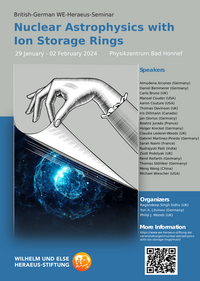Nuclear Astrophysics with Ion Storage Rings
British‐German WE-Heraeus-Seminar
29 Jan - 02 Feb 2024
Where:
Physikzentrum Bad Honnef
Scientific organizers:
Dr. Ragandeep Singh Sidhu, U Edinburgh, UK • Prof. Dr. Philip J Woods, U Edinburgh, UK • Prof. Dr. Yuri A. Litvinov, GSI Darmstadt

Our understanding of stellar nucleosynthesis processes is inevitably connected to our knowledge of the properties of exotic nuclei. For instance, the rapid neutron-capture process (r-process), which is believed to be responsible for the production of about one-half of all elements heavier than iron as well as of all thorium and uranium, goes through neutron-rich nuclei far away from the valley of beta-stability. Another example is the rapid proton-capture process (rp-process) powering X-ray bursters, which proceeds along the proton drip line, the imaginary line on the chart of the nuclides beyond which the nuclei are unstable with respect to the emission of a proton. To describe these and other nucleosynthesis processes, various nuclear properties of the exotic nuclei involved are needed.
The advent of radioactive ion beam facilities enabled access to many relevant exotic nuclei. However, a lot of experimental information still remains inaccessible. New experimental developments are required and the ion storage rings provide here new, still unexploited, experimental possibilities. Originally intended for the storage of atoms and nuclei, heavy ion storage rings have also become indispensable tools in the field of nuclear astrophysics. Revolution frequencies of the cooled ions give access to ground state masses and excitation energies of isomeric states. Monitoring particle intensities as a function of storage time gives straightforward access to nuclear half-lives. These data are crucial for astrophysics applications since the nuclear masses and half-lives primarily determine the pathways and the speed of the nucleosynthesis processes on the chart of the nuclides, respectively. Moreover, very recently, storage rings equippedwith thin gas-jet targets have opened doors for in-ring reaction studies that are pivotal for the understanding of the processes that forge the elements in stars and the big bang.
The goal of the seminar is to bring together global experts from experiment and theory in the field working on various storage ring projects for a constructive discussion of the most promising paths to maximize the impact of the available facilities and exploit synergies among the groups. Besides the invited presentations on the status of the leading facilities, the potential of new technological developments will also be discussed. Students and young researchers in the field will have theopportunity to present their ideas in the form of contributed talks and poster presentations.
Download seminar poster (pdf)
The conference language will be English. The Wilhelm and Else Heraeus-Foundation bears the cost of full-board accommodation for all participants.

